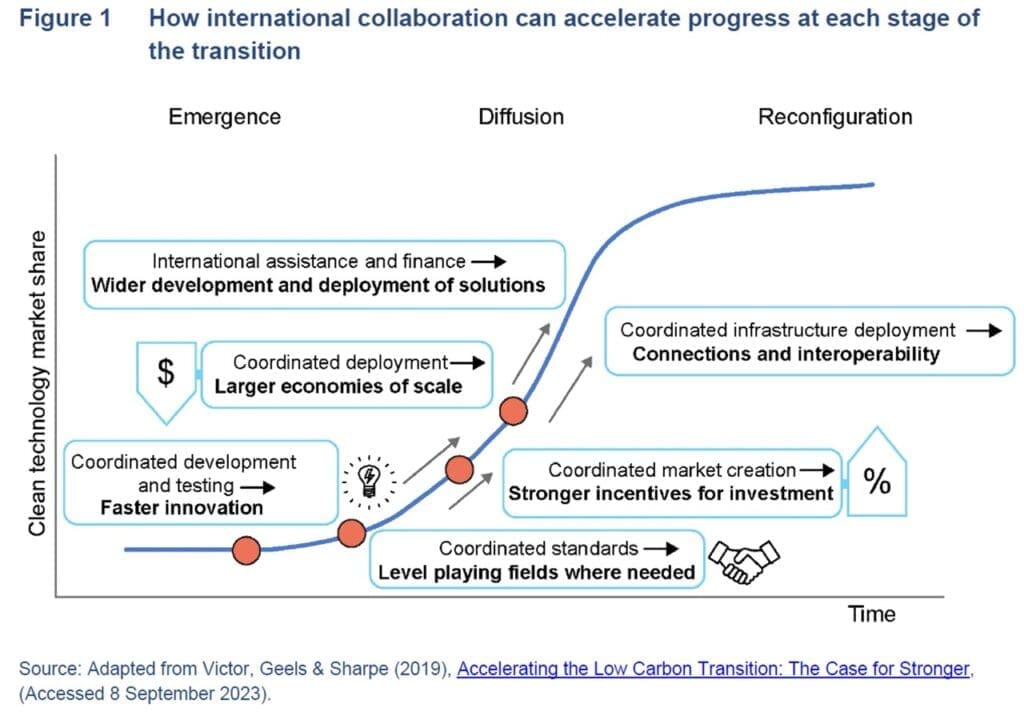Climate change has turned into a real climate emergency or crisis. July 2023 was recorded as the hottest month in 120.000 years, while geopolitical confrontations are getting exacerbated in different regions like Ukraine, Syria, Yemen, Gaza and others. The United Nations Security Council has been in intensive care for a long time due to an undeclared war between Western countries and Russia over Ukraine. The power struggle between China and the USA continues in the Pacific region. On the other hand, the frequency and magnitude of environmental disasters related to climate change, such as wildfires, floods, droughts and heatwaves, have become more conspicuous. By the EU Green Deal, the EU has put forward the most comprehensive and ambitious climate policies until now. The critical question is whether the EU’s efforts will be enough to trigger the enactment of similar regulations worldwide and establish a common ground for other nations to cooperate on developing effective and coordinated actions to tackle the negative consequences of climate change.
Current emission and climate finance trends
According to UNEP’s new “Adaptation Gap Report 2023”, the climate finance gap has reached $194-366 billion per year, while the number of extreme weather events such as floods in China, wildfires in Canada, prolonged draughts in Africa are getting increased both in size and scope. Global warming is expected to reach s 2.4°C–2.6°C at the end of this century.

Figure – 1: Emission Scenario (Source: UNEP)
Net-zero transition in hard-to-abate sectors is critical in this decade to tackle the negative impacts of climate change. Although advanced economies have sufficient technical expertise and financial resources to invest in clean technologies, developing countries, most susceptible to climate-related environmental disasters, are struggling to develop and implement projects to achieve their net-zero targets. The level of coordination among world countries regarding technical assistance, financial support and establishment of interoperable global carbon club is inadequate for achieving net-zero targets by the middle of this century.

Figure-2: Collaboration in the development of clean techs (Source: Breakthrough Agenda)
EU’s common approach in COP 28
The main agenda topics of COP 28 can be summarized as the first global stocktake, climate mitigation, climate adaptation and loss & damage fund. Ambitious climate action and just transition are the core tenets of the European Union’s approach for the 28th United Nations Climate Change Conference (COP 28) held in Dubai from 30 November to 12 December 2023.
Managing to reduce its GHG emission by 32.5% compared to the emissions in 1990, the EU has submitted its updated Nationally Determined Contribution (NDC) that is compatible with the targets of the EU Green Deal. Revision of the EU Emission Trading System, introducing Carbon Border Adjustment Mechanism for certain imported goods, corporate sustainability regulations and new eco-design criteria for sustainable products are flagship political responses of the EU that aim at forcing companies in its territory and other countries to embrace low carbon economy practices and adopt clean technologies. The financial contribution of the EU to global climate action reached €28.5 billion. The expectations of the EU from COP 28 are;
- Termination of unabated fossil fuel use
- Decarbonization of the global power system
- Tripple the deployment of renewable energy systems and double the energy efficiency rate
Uncertainty in the future of EU Green Deal
Nationalism, protectionism, authoritarianism and populism are gaining momentum among most countries, including the members of the EU. “Shifting political winds” in the EU raises suspicion on the future effectiveness of the new regulations under the EU Green Deal. Right-wing populist parties such as in Finland, Italy, Sweden and Hungary are standing aloof from climate policies such as phasing out fossil fuels and biodiversity policies. For instance, Christian Lindner, finance ministry of Germany and the leader of the Free Democratic Party, withdrew his party’s support related to the phasing out coal power plants. Some politicians in the EU fear that stricter climate policies will create greenflation and in turn social unrest. It can trigger the rise of hard-right parties in the EU. Trump-like politicians are not eager to take the burden of climate policies away from developing nations.
Conclusion
While the world is proceeding into uncharted territories with rising global temperatures, the international order is in perfect storm. The ongoing war in Ukraine has blocked the functioning of the UN Security Council and disrupted the global supply chains. Humanitarian tragedy in Gaza has exacerbated the division between Western and Eastern societies. Record-breaking temperatures, floods, and wildfires are trailers of the future scenes of climate-related disasters that humanity will suffer.
The EU tries to strike the right balance between implementing its climate policies and protecting its economy & social support. Until now, Green Deal regulations such as CBAM and Corporate Sustainability Reporting Directive have created a butterfly effect in other regions due to strong trade relationships (Brussel effect) of EU members with other countries. Having said that, in these days, the principles of Realpolitik are commonly applied by major powers in both economic and security areas. As a result, policy-makers in the EU should find creative and balanced ways to continue its leading role in global climate policies without losing the support of its citizens and strengthen climate collaboration among world nations by sharing its financial capacity & technical expertise to spread its democratic values in a way to prevent the rise of authoritarianism in the world politics.

